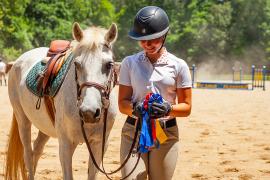Just like schools this past fall, camps across the nation are beginning to dive into the unfamiliar waters of COVID-19 testing. At this point, terms like PCR, antibody, and antigen are becoming parts of our everyday lives. But have you ever wondered exactly what happens between swabbing your nose and getting your results back? We'd like to give you a look inside the lab and demystify the experience.
First of all . . . what is a virus?
So, first things first, viruses — like all microbes — are everywhere! We really can't avoid being surrounded by them. ¯\_(ツ)_/¯ And truth be told, they've been here long before we were here. We've grown up with them, literally and historically.
But what are these things? On a basic level, a virus is just a tiny little thing that contains instructions for making copies of itself. That's it! These little things we call viruses are just odd little genetic packages that only want one thing: to make more of themselves. The problem is that they want to do that endlessly. And that can be bad for us! (But sometimes it can be fine or just OK or not matter at all!)
The shell of the virus — the package, if you will — that contains its instructions can come in different shapes and be made of different things. The full set of instructions is called a genome and each individual instruction is called a gene. (Quick note: scientists get to make up a lot of words! See our glossary at the bottom of this post for short definitions.)
You can think of a genome as a recipe book: the genome is the entire book, and the genes are the individual recipes. Everything that's made up of cells (like people, plants, animals, and even bacteria) has genomes made up of DNA. But viruses can have genomes made up of either DNA or RNA, which are both types of genetic material. You can think of DNA and RNA as the letters that make up each recipe. When a cell "reads" them, it is reading a recipe — a set of instructions — to make something like a single part of a virus.
So, when our bodies get infected by a virus, our body is reading the virus's recipe book, making each recipe, and the end result is a copy of the virus! The virus has tricked us. Our body thought it was doing the right thing, assembling each recipe one by one, and then at the end it steps back to admire its work and realizes it's made a copy of a virus. Oh no!
Okay, but hold on, you're talking about "reading" DNA and RNA. What are DNA and RNA? And how do you read them?
Like we mentioned, DNA and RNA make up genes. If genes are instructions, then each molecule of DNA or RNA is one letter. The individual molecules form long, tiny strands of genetic material. Cells are able to "read" these strands using tools that are found in all living things. When a cell "reads" a gene, it makes whatever the gene instructs it to make.
DNA and RNA are almost identical, but there's a tiny chemical difference that makes DNA more "stable" than RNA. Compared to DNA, RNA genomes accumulate random changes incredibly quickly. That's why we need a new vaccine for the flu (a virus that uses RNA) every year. When the genes change, that makes a slightly different variant of the virus — which needs a slightly different vaccine.
@swabsession The one where Jake takes a covid test #science #biotok #covid19
♬ original sound - low effort biotech
Genomes made of DNA also randomly change, but it happens much less often. That's what makes DNA particularly good for long-term storage. If you're much more complicated than a virus (like a person!), it's a bigger problem if your genes randomly change all the time.
Since these two types of genetic material are closely related, you can make a strand of DNA that matches a strand of RNA and vice versa. How? That's outside of this post, but you can read more about it here and here. When cells "read" DNA, they have to transcribe them into RNA first. This process of copying DNA to make RNA is called transcription.
Okay, back to our actual topic: how do COVID tests work? Rapid antigen tests, which give results in just a few minutes, look for the shell of the virus. Molecular tests, like PCR tests, work by looking for certain genes of the virus. (Remember: DNA and RNA are types of molecules; that's why we use the term ‘molecular test.') Although PCR tests take longer, they also tend to be more accurate.
How does PCR work?
Okay, strap in, we're about to introduce PCR's full name.
Ready?
Polymerase chain reaction
Phew. You still with us? Now, what do those words even mean?
Really all you need to know is that PCR is a way to make lots and lots of copies of DNA. That's why it has the words "chain reaction" in it: we start a chain reaction to make millions of copies, so that we can "see" the copied DNA using special tools.
You might be thinking, "Hold on, I thought you said COVID was an RNA virus? But now you're talking about DNA." You're right! It is an RNA virus. We first convert the RNA to DNA (which is called reverse transcription).
An important part of the PCR process is something called a primer. Primers are actually short pieces of DNA themselves. They attach to specific sequences of DNA that make up a gene. You can think of the primers and the genes of the virus like puzzle pieces that fit together.
If the virus isn't in the sample you and your pooling pod swabbed from your noses, the primers don't have anything to attach to, and nothing happens — that's a negative test! But if the primers do find their counterpart pieces — that is, if the virus's genes are present, then the primers get to work and the chain reaction begins.
The first copy of the gene is copied, then both of those copies are copied. Then, the copies of those copies get copied. And on and on like that until there are so many copies that it's easy to "see" them — that's a positive test.
It's important to note that PCR isn't making a copy of the entire virus. All that's copied is a small, harmless gene. To use our recipe book analogy: just a single recipe is made, not all of them.
The reason these tests are so good at identifying whether the virus is in a sample or not is that, theoretically, you only need to start with one copy (that is, just one tiny virus) to kick off the chain reaction. In reality, though, having more than one copy of a virus in a sample makes it easier for the primers to do their job.
You mentioned the word "sequences." What does that mean?
Some labs just use PCR, but some use a combination of PCR and a process called sequencing. This term refers to "reading" genetic material. You can think of sequencing as recording the individual letters of genetic instructions. Thus, sequencing = reading DNA!
The difference between PCR and sequencing is that PCR gives us a simple "yes" or "no" answer to whether the genes of the virus — and thus, the virus — are present in a sample. Sequencing gives us a "yes" or "no" answer too but it can also read and record the viral genes as well. This gives us more detail about the virus, which can be useful for detecting new variants. But, for the purposes of a regular COVID-19 test, sequencing is just another way of confirming "yes" or "no" to the question "Is the virus in this sample?"
You may have heard of "DNA companies" that can tell people about their ancestry. These companies use sequencing to intentionally read human DNA. COVID-19 tests use the same type of technology but are specifically designed just to detect the virus. So, while the lab can't tell if you're 20 percent Italian, they can tell whether or not you're likely to be infected with COVID-19.
Where can I find more information?
For more information, check out these educator resources and more educational videos on TikTok. Even though we're living through difficult — sometimes even scary — times, we believe there's always an opportunity to learn. The more we all learn about biology, the better we will be at responding to this and future pandemics, and the less scary the world becomes.
Tweet us @ginkgo or send us an email at [email protected] if you find educational resources that are fun or helpful — we'd love to hear about it!
Glossary
- Cell: At a minimum, a cell is made of a membrane (you can think of a membrane like the plastic part of an inflated balloon) that contains what the cell needs to survive and replicate itself.
- DNA: The molecule that's used by living things for long-term storage of genetic information.
- Gene: "Gene" is actually a very tricky word to define! Nowadays, it usually means the sequence that instructs a cell to make a certain product.
- Genome: The complete set of all genes in a living thing.
- Molecular tests: When referring to COVID-19 tests, a test that works by detecting the genetic code of the virus.
- PCR (polymerase chain reaction): A technique that makes very many copies of a piece of DNA.
- Primer: A small piece of DNA that provides a starting point for copying another piece of DNA.
- Reverse Transcription: The process of converting RNA into DNA. The opposite process (converting DNA to RNA) is called transcription.
- RNA: Like DNA, RNA can provide instructions for making certain products. But it can also do more, like help cells carry out chemical reactions.
- Sequence: A series of specific molecules of DNA or RNA that make up a longer strand.
- Sequencing: Recording the specific molecules that make up a strand of DNA or RNA.
- Transcription: The process of converting DNA into RNA. The opposite process (converting RNA to DNA) is called reverse transcription.
- Virus: Genetic material protected by an outer shell that enters living cells in order to replicate itself.
This blog post was provided by Ginkgo Bioworks.
Periodically, the American Camp Association (ACA) makes timely and relevant information about products and services available to its members so they can make informed decisions for their camps. However, the ACA does not endorse products, services, or companies.
The views and opinions expressed by contributors are their own and do not necessarily reflect the views of the American Camp Association or ACA employees.



